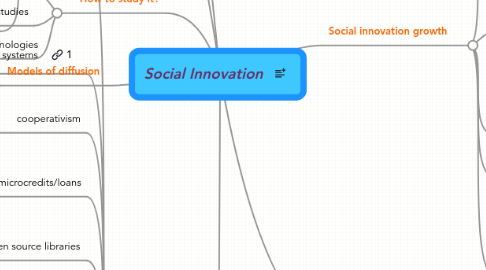
1. Some definitions
1.1. "The term refers to the generation and implementation of new ideas about how people should organize interpersonal activities, or social interactions, to meet one or more common goals" in "Social innovation: Ten cases from Benjamin Franklin", Michael D.Mumford, Creativity Journal, 2002, vol.14, N°2, 253-266
1.2. "Social Innovation refers to new strategies, concepts, ideas and organizations that meet social needs of all kinds - from working conditions and education to community development and health - and that extend and strengthen civil society. [..] It can be used to refer to social processes of innovation, such as open source methods. Alternatively it can be used to innovations which have a social purpose - like microcredit or distance learning. The concept can also be related to social entrepreneurship (entrepreneurship isn't always or even usually innovative, but it can be a means of innovation) and it also overlaps with innovation in public policy and governance. Social innovation can take place within government, within companies, or within the nonprofit sector (also known as the third sector), but is increasingly seen to happen most effectively in the space between the three sectors" Source: wikipedia
1.3. Social innovations uderstood as they:" > Can be defined and potentially spread beyond their initial context (and are not entirely context-specific) > Are provided by organisations rather than being only about lifestyle choices; > Meet socially recognised needs (as opposed to merely personal needs or demands); and > Work in circumstances where normal commercial markets and existing public organisations have failed" "In and out of sync, The challenge of growing social innovations", Geoff Mulgan with Rushanara Ali, Richard Halkett and Ben Sanders, NESTA, 2007
2. How to study it?
2.1. Main difficulty to study social innovation is methodological "social innovation are typically diffuse events involving interactions among multiple parties over rather long periods [..] identification and attribution of a creative act is not at all easy" p°254
2.2. Historic and leadership studies
2.3. identifying introduction, development, adoption innovation inside processes and technologies
3. Models of diffusion
3.1. uncontrolled diffusion
3.2. more directed diffusion by a 'parent' organization
3.2.1. promotion through informal and formal networks
3.2.2. multiplication
3.2.3. licensing
3.2.4. franchising
3.2.5. Being taken over by larger organizations
4. Some examples
4.1. FLOSS
4.1.1. GnuLinex
4.1.1.1. Spain> Extremadura
4.1.2. UBUNTU
4.1.3. femmes et logiciels libres
4.1.4. LinexCol
4.1.5. mozilla
4.2. local trade exchange systems
4.2.1. LETs and SOL
4.2.1.1. Uk and France
4.3. cooperativism
4.3.1. infoespai
4.3.1.1. catalonia
4.3.2. xarxa sense fils
4.4. microcredits/loans
4.4.1. kiva
4.4.1.1. international
4.5. virtual open source libraries
4.5.1. gutenberg project
4.5.1.1. cyberspace
4.5.2. mitopencourseware
4.5.2.1. mit and cyberspace
4.6. wifi communities
4.6.1. FON
4.6.1.1. international
4.6.2. meraki
4.7. geo-references
4.7.1. google-earth
4.7.1.1. mapping genocide in darfur
4.7.1.1.1. cyberspace
4.7.1.2. katrina peoplefinder project
4.7.1.3. tunisian prison map
4.7.2. PPGIS
4.7.2.1. MapHub
4.7.2.2. Maprain
4.7.2.3. Mapserver
4.7.2.4. CMAP: Who represents me?
4.7.2.5. healthcarethatworks
4.8. hardware durable
4.8.1. la fabrique du libre
4.8.1.1. france> nantes
4.8.2. one laptop per child
4.8.2.1. international
4.8.3. designthatmatters
4.8.3.1. africa
4.8.4. openarchitecture
4.8.4.1. international
4.8.5. Symputer
4.8.5.1. india
4.9. virtual environments
4.9.1. secondlife grid
4.9.1.1. cyberspace
4.10. Benjamin Franklin: the subscription library / fire department/etc.
4.11. the ultimate state of SI: self-management as autopoïesis
4.12. education/research/development
4.12.1. hacklabs
4.12.2. r23.cc
4.12.3. Lanl.arXiv.org e-print archive
5. ThirdSector/CivilSociety Specificities
5.1. possible "added value"
5.1.1. niche of expertise isndie Voluntary and Community Organizations (VCO)
5.2. possible "association revolution" (Salamon and Anheir)
5.2.1. public services delivery by third sector increasing
6. alternative pathways in science and industry
6.1. epistemic modernization
6.1.1. diversification of social composition
6.1.2. community-oriented research
6.1.2.1. in 70s developement in europe of #science shops#
6.1.2.2. community based participatory research and environemental justice
6.1.2.3. Paulo Freire "methodology of the oppressed"
6.1.3. activist reserach
6.1.3.1. action research
6.1.3.2. participative research
6.1.3.3. con-ricerca
6.2. through opposition/ non-dominant research fields /
7. Social innovation growth
7.1. pull factors "effective demand"
7.1.1. innovators as campaigners
7.1.2. timing
7.1.3. identification of direct and indirect consumers appropriate
7.1.4. money availability
7.1.5. structures of power
7.2. push factors "effective supply"
7.2.1. relative advantage
7.2.2. compatibility and complementary conditions
7.2.3. weak competition
7.2.4. simplicity
7.2.5. Cheapness and value for money
7.3. Trial and error processes
7.4. Big specificity social innovation: LACK of MONEY
7.5. systemic weakness diffusion
7.5.1. weak incentives for public agencies and NGOs to copy or fund more effective alternative models
7.5.2. absence of intermediary bodies and networks that specialise in connecting supply and demand
7.5.3. relative absence of resources for social research and development
7.5.4. lack of access to capital to fund growth in social organisations
7.5.5. under-developed labour markets for managers to oversee growth
